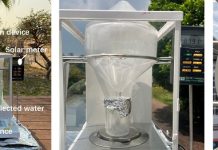
Chemists at Saarland University have achieved a groundbreaking feat by synthesizing a molecule that was first predicted 20 years ago.
This molecule, known as a “heterobimetallic sandwich complex,” contains two different metal atoms, making it the first of its kind.
Metallocenes, also known as sandwich complexes, are molecules where a single metal atom is sandwiched between two flat rings of carbon atoms.
The most famous example is ferrocene, which contains an iron atom.
These molecules are widely studied in chemistry and have many industrial applications, such as catalysts and in the creation of special metallopolymers.
For a long time, it was believed that all sandwich molecules contained only one metal atom.
This changed in 2004 when a research team from the University of Seville synthesized a molecule with two zinc atoms, creating the first “dimetallocene.” Last year, a UK group created a similar molecule with two beryllium atoms.
Now, Inga Bischoff, a doctoral student in Dr. André Schäfer’s research team at Saarland University, has gone a step further. She successfully created the world’s first heterobimetallic sandwich complex, containing two different metal atoms.
After the discovery of the first dimetallocene, theoretical studies suggested that these molecules could also contain two different metal atoms and still be stable.
These predictions were made using quantum-chemical modeling and powerful computers.
However, despite these predictions, no one had managed to create such a molecule in the lab until Bischoff’s breakthrough.
“It’s really exciting when you realize what you’re holding in your hands,” said Dr. Schäfer. “To the naked eye, it just looks like another white powder.
But I can still clearly remember the moment when we first saw the molecular structure on the computer screen and knew we had a sandwich molecule with two different metal atoms.”
Bischoff explained that the choice of carbon rings is just as important as the choice of metal atoms. “The electronic structures of the cyclic carbon rings and the metal atoms have to match one another,” she said.
In their new molecule, the metals used were lithium and aluminum. Theoretical calculations indicated that these metals would work well together because their electronic structures are similar to those of two zinc atoms, which are known to form stable dimetallocenes.
Creating this molecule was not easy. It is so reactive that it can only be synthesized, stored, and analyzed under an inert atmosphere of nitrogen or argon. Exposure to air would cause it to decompose.
After synthesizing the molecule, the team needed to characterize it. This involved a whole team of scientists at Saarland University, and their findings have been published in the journal Nature Chemistry.
“Our heterobimetallic dimetallocene represents a whole new class of sandwich molecules,” said Dr. Schäfer. “It might even be included in student textbooks one day. But first, we need to study it further.”
The team currently understands the molecule’s structure well but knows little about its reactivity. Dr. Schäfer believes that finding other suitable combinations of metal atoms could lead to the creation of more heterobimetallic dimetallocenes in the future.
This discovery opens up new possibilities in the field of chemistry, potentially leading to new materials and applications that we can only begin to imagine.
Source: KSR.



